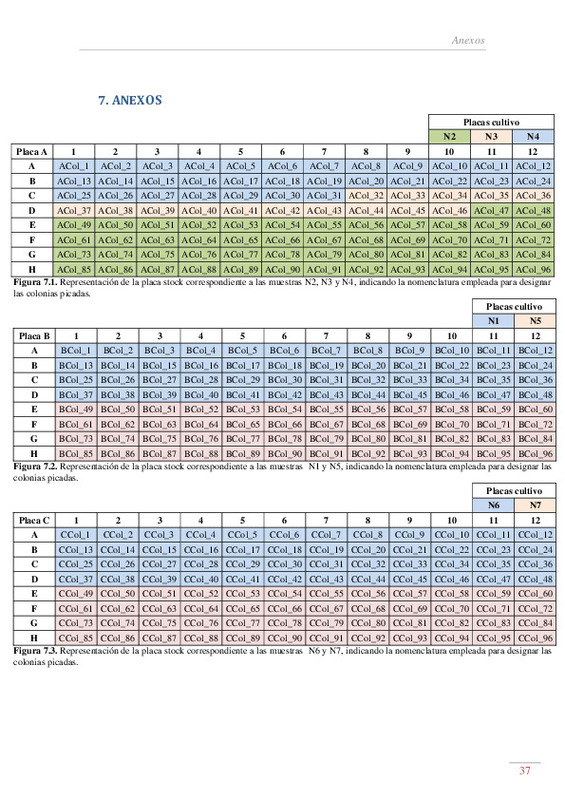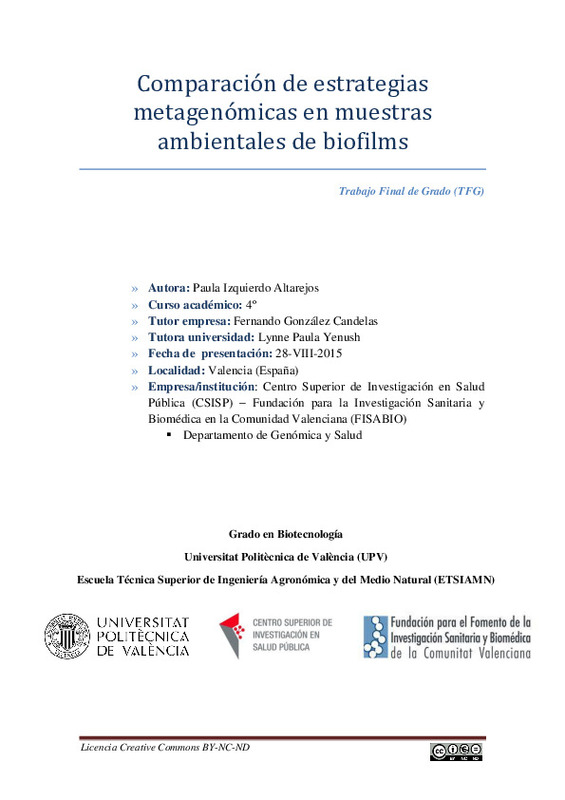|
Resumen:
|
[ES] Los objetivos principales del trabajo son analizar la población bacteriana presente en muestras ambientales de biofilms y comparar los resultados obtenidos mediante tres técnicas: secuenciación de metagenomas completos ...[+]
[ES] Los objetivos principales del trabajo son analizar la población bacteriana presente en muestras ambientales de biofilms y comparar los resultados obtenidos mediante tres técnicas: secuenciación de metagenomas completos antes del cultivo, búsqueda activa de las regiones del 16S en estos metagenomas y secuenciación de regiones específicas del 16S rDNA.
La parte experimental del proyecto consistirá en el análisis individual de las colonias crecidas en cultivo, empleando extracción del material genético, amplificación de las regiones hipervariables V1-V4 del 16S rDNA con cebadores universales, purificación de los amplicones, secuenciación mediante la técnica Sanger y análisis de las secuencias, apoyándose en herramientas bioinformáticas y bases de datos fundamentadas en el DNA ribosomal.
Se compararán las especies bacterianas detectadas mediante cada enfoque, así como su abundancia relativa, identificando las variaciones y señalando posibles razones de los sesgos encontrados.
[-]
[EN] The main purposes of this study are to characterize the bacterial
community present in environmental samples of biofilms and compare the
results obtained using three different approaches: metagenomics without ...[+]
[EN] The main purposes of this study are to characterize the bacterial
community present in environmental samples of biofilms and compare the
results obtained using three different approaches: metagenomics without prior
culturing using NGS technologies, active search of 16S ARNr regions within
the metagenomes obtained and sequencing of specific regions of the 16S
rRNA from colonies grown in culture. The analyzed samples were obtained in
natural springs in the region of Alcoy (Alicante, Spain) and they show
epidemiological interest due to the known endemism of the pathogenic
bacteria Legionella pneumophila in this area.
The experimental workflow of the project involved the analysis of
individual colonies grown on GVPC medium using DNA extraction,
amplification of the V1-V4 hypervariable regions with universal 16S rRNA
primers, amplicons purification, Sanger sequencing and sequence analysis,
using bioinformatic tools and databases focused on the ribosomal RNA. This
methodology allowed assigning most sequences to the genus level, but the
resolution was not enough for the accurate identification of species, except for
a low number of the colonies.
According to the 16S sequencing, the bacterial community studied is
made up of 3 phyla, 6 classes, 13 orders, 19 families and 26 genera. Within
the main phyla, the community was found to be dominated by Proteobacteria,
with a relative abundance greater than 80 %, especially the
Gammaproteobacteria class, representing 70 % of the total population.
Regarding the order and family levels, Aeromonadales and Aeromonadaceae
stood out, respectively, both with a relative abundance greater than 50 %. At
the genus level, the abundance of Aeromonas (53'61 %) was remarkable,
pointing out the possibility that the culture medium used (GVPC) somehow
improves their growth.
About the presence of pathogens, the genus Legionella was not detected
despite its endemism in the area. Nevertheless, it was found a surprisingly
high percentage of pathogenic related genera.
In the comparison between the community characterized according to the
regions of 16S rRNA and the distribution obtained with the metagenomic
approach by NGS only minor similarities or just at general levels were found,
but at the genus level the results were very different. According to the data
generated from the 16S sequences retrieved from the metagenomes, no strong
correlation was found. Differences and biases are likely due to the sample size
(in the 16S study only a fraction of the community was analyzed), the step of
culturing on GVPC medium and the databases in which each approach rely.
[-]
|








